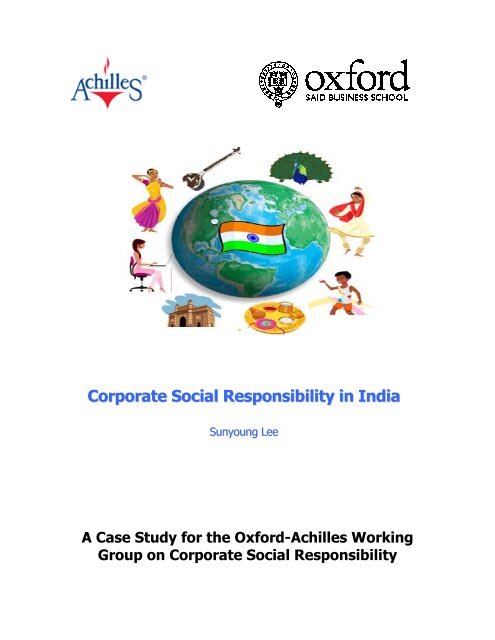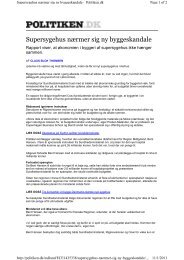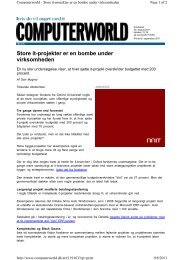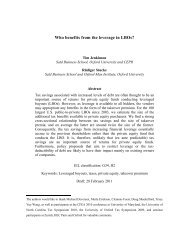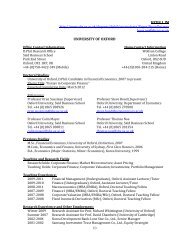Corporate Social Responsibility in India - Said Business School
Corporate Social Responsibility in India - Said Business School
Corporate Social Responsibility in India - Said Business School
Create successful ePaper yourself
Turn your PDF publications into a flip-book with our unique Google optimized e-Paper software.
<strong>Corporate</strong> <strong>Social</strong> <strong>Responsibility</strong> <strong>in</strong> <strong>India</strong><br />
Sunyoung Lee<br />
A Case Study for the Oxford-Achilles Work<strong>in</strong>g<br />
Group on <strong>Corporate</strong> <strong>Social</strong> <strong>Responsibility</strong>
The Oxford-Achilles Work<strong>in</strong>g Group on <strong>Corporate</strong> <strong>Social</strong> <strong>Responsibility</strong><br />
(CSR) is an <strong>in</strong>itiative between Oxford University’s Saïd Bus<strong>in</strong>ess <strong>School</strong><br />
and the Achilles Group. Its purpose is to stimulate th<strong>in</strong>k<strong>in</strong>g, to promote<br />
and dissem<strong>in</strong>ate research, and to br<strong>in</strong>g together researchers and<br />
practitioners. For further <strong>in</strong>formation, see:<br />
http://www.sbs.ox.ac.uk/research/<strong>Corporate</strong>+<strong>Social</strong>+<strong>Responsibility</strong>/<br />
The papers <strong>in</strong> this White Paper Series reflect the views of the authors,<br />
and are not necessarily shared by the Achilles Group. This White Paper is<br />
an edited version of a longer paper, available on request from the<br />
authors.<br />
1
���� ���� ���� ���� ���� ����<br />
INTRODUCTION<br />
���� ���� ���� ���� ���� ����<br />
“<strong>Corporate</strong> social responsibility must not be<br />
def<strong>in</strong>ed by tax plann<strong>in</strong>g strategies alone.<br />
Rather, it should be def<strong>in</strong>ed with<strong>in</strong> the<br />
framework of a corporate philosophy which<br />
factors the needs of the community and the<br />
regions <strong>in</strong> which a corporate entity<br />
functions. This is part of our cultural<br />
heritage. Mahatma Gandhi called it<br />
trusteeship….I <strong>in</strong>vite corporate <strong>India</strong> to be a<br />
partner <strong>in</strong> mak<strong>in</strong>g ours a more humane and<br />
just society… We need a new Partnership for<br />
Inclusive Growth based on what I describe<br />
as a Ten Po<strong>in</strong>t <strong>Social</strong> Charter...first, we need<br />
to have healthy respect for your workers<br />
and <strong>in</strong>vest <strong>in</strong> their welfare…” .<br />
<strong>India</strong>n Prime M<strong>in</strong>ister,<br />
Manmohan S<strong>in</strong>gh <strong>in</strong> 2007<br />
���� ���� ���� ���� ���� ����<br />
The speech above touches upon three<br />
important issues <strong>in</strong> contemporary<br />
discussions about CSR: 1) the role of<br />
government <strong>in</strong> relation to CSR 2) the drivers<br />
of CSR and 3) the end results of CSR. Mr.<br />
S<strong>in</strong>gh implicitly suggests that <strong>India</strong>n CSR<br />
must be a voluntary activity that gives<br />
companies free hands with respect to the<br />
government. A strong cultural heritage is a<br />
key driver of <strong>India</strong>n companies to become<br />
engaged <strong>in</strong> CSR. The outcome they strive<br />
2<br />
for is a better society which is more<br />
humane and just; <strong>in</strong> achiev<strong>in</strong>g this, their<br />
approach doesn’t just focus on community<br />
development projects or philanthropy, but<br />
also <strong>in</strong>cludes extensive programs for<br />
employees.<br />
Build<strong>in</strong>g upon the po<strong>in</strong>ts made <strong>in</strong> the<br />
speech, the purpose of this study is to<br />
characterize the CSR activities of <strong>India</strong>n<br />
bus<strong>in</strong>esses and highlight the unique<br />
features of <strong>India</strong>n CSR. In do<strong>in</strong>g so, we<br />
identify good CSR practices <strong>in</strong> <strong>India</strong>, from<br />
which <strong>India</strong>n firms can benefit <strong>in</strong><br />
competitive global markets and from which<br />
Western firms might learn. This case study<br />
is based primarily on 50 semi-structured<br />
<strong>in</strong>terviews with policymakers, bus<strong>in</strong>ess<br />
people, practitioners and researchers, which<br />
were conducted <strong>in</strong> <strong>India</strong> dur<strong>in</strong>g the summer<br />
of 2008.<br />
���� ���� ���� ���� ���� ����<br />
PART I: OVERVIEW<br />
CSR has a long tradition<br />
As Mr. S<strong>in</strong>gh po<strong>in</strong>ted out, one of the key<br />
drivers of <strong>India</strong>n corporate social<br />
responsibility is found <strong>in</strong> the country’s
cultural heritage. The concept of<br />
“trusteeship” asserts the right of the<br />
capitalist to accumulate and ma<strong>in</strong>ta<strong>in</strong><br />
wealth and to use it to benefit society<br />
(Narayan 1966). Researchers have<br />
established connections between CSR and<br />
trusteeship (Renold 1994; Masani 1956;<br />
Pachauri 2004). Gandhi’s view of the<br />
ownership of capital was one of trusteeship,<br />
motivated by the belief that essentially<br />
society was provid<strong>in</strong>g capitalists with an<br />
opportunity to manage resources which<br />
need to be managed on behalf of society <strong>in</strong><br />
general.<br />
As the tradition suggests, almost every<br />
large corporation <strong>in</strong>volved <strong>in</strong> the <strong>India</strong>n<br />
market today is engaged <strong>in</strong> some form of<br />
social <strong>in</strong>itiative <strong>in</strong> <strong>India</strong> although this is not<br />
well documented. CSR penetration <strong>in</strong> <strong>India</strong><br />
is relatively high with over 80 percent<br />
corporations adm<strong>in</strong>ister<strong>in</strong>g some k<strong>in</strong>d of<br />
corporate social responsibility program; this<br />
exceeds some of <strong>India</strong>’s counterparts <strong>in</strong><br />
Asia, especially Malaysia, Japan, Korea,<br />
Thailand, S<strong>in</strong>gapore and the Philipp<strong>in</strong>es that<br />
are economically more prosperous than<br />
<strong>India</strong>. (Chambers et al 2003).<br />
Keep a low profile<br />
Despite the high penetration, CSR activities<br />
of <strong>India</strong>n bus<strong>in</strong>esses are not well recognized<br />
3<br />
at the global level. Diverse stakeholders <strong>in</strong><br />
<strong>India</strong> <strong>in</strong>terviewed have po<strong>in</strong>ted out that<br />
<strong>India</strong>n companies' CSR programs are<br />
significantly underestimated. An immediate<br />
explanation would be that contemporary<br />
CSR <strong>in</strong>ternational rank<strong>in</strong>gs based on the<br />
cont<strong>in</strong>ued emphasis on the corporate<br />
bottom l<strong>in</strong>e fall short to assess CSR<br />
performance of <strong>India</strong>n firms as they address<br />
social problems like poverty, health, and<br />
education.<br />
Another reason might be <strong>India</strong>ns<br />
themselves. They believe it is not<br />
appropriate to talk about the good deeds<br />
that they are do<strong>in</strong>g. The rule of 'Do not let<br />
the right hand know what the left hand is<br />
do<strong>in</strong>g' is predom<strong>in</strong>antly be<strong>in</strong>g applied to the<br />
case of CSR. Only 17 percent of the<br />
companies surveyed <strong>in</strong> <strong>India</strong> had a written<br />
CSR policy while more than 80 percent of<br />
the surveyed companies engage <strong>in</strong> CSR<br />
programs (Partners <strong>in</strong> Change 2005).<br />
���� ���� ���� ���� ���� ����<br />
PART II: WHY CORPORATE SOCIAL<br />
RESPONSIBILITY?<br />
Many companies <strong>in</strong> <strong>India</strong> start CSR<br />
programs as a response to dissatisfaction<br />
with the prevail<strong>in</strong>g social order and an urge
to improve it. It is often the case that CSR<br />
programs emerge out of the founders'<br />
desires to create alternatives which<br />
challenge exist<strong>in</strong>g models, and their<br />
corporate practices are shaped by their<br />
underly<strong>in</strong>g deontological views about social<br />
reality. The motivation for socially<br />
responsible activities of companies often<br />
comes from the leadership and orientation<br />
of top management (Sood and Arora 2006).<br />
Alternatives to exist<strong>in</strong>g order can be put<br />
<strong>in</strong>to three categories: alternatives to the<br />
state, alternative community and<br />
alternatives to the market.(Schwabenland<br />
2006) In <strong>India</strong>, alternatives to the state and<br />
alternative community seem to be<br />
prevail<strong>in</strong>g, while market alternatives are<br />
less noticeable.<br />
1) Alternatives to the state<br />
There has been a global trend toward<br />
greater <strong>in</strong>volvement of the private sector <strong>in</strong><br />
the division of responsibility between the<br />
state and the private sector for the delivery<br />
of public goods and services. The <strong>India</strong>n<br />
government faces many challenges <strong>in</strong><br />
address<strong>in</strong>g the immense problem of poverty<br />
<strong>in</strong> the country. The public sector has<br />
partnered with the private sector <strong>in</strong> <strong>India</strong><br />
for sometime now. The real shift, however,<br />
took place <strong>in</strong> the 1990s when <strong>India</strong><br />
4<br />
liberalized its economy, an event brought<br />
about by a prolonged national f<strong>in</strong>ancial<br />
crisis. The private sector was allowed to<br />
operate <strong>in</strong> many areas that had been<br />
previously reserved for the public sector,<br />
and was given more opportunities to<br />
compete <strong>in</strong> more segments of the economy<br />
(GBC 2007).<br />
The performance and activities of the public<br />
sector on welfare has not always escaped<br />
criticisms from <strong>in</strong>dustrialists <strong>in</strong> <strong>India</strong>.<br />
Industry leaders <strong>in</strong> <strong>India</strong> have repeatedly<br />
blamed the government’s poor performance<br />
<strong>in</strong> education for the dearth of qualified<br />
candidates and the ‘poor quality’ of most<br />
eng<strong>in</strong>eer<strong>in</strong>g graduates, and argued that<br />
steps should be taken to make young<br />
people from rural areas and lower castes<br />
more competitive <strong>in</strong> the job market,<br />
especially by improv<strong>in</strong>g the quality of school<br />
education.<br />
The IT <strong>in</strong>dustry has taken steps to upgrade<br />
and re-orient eng<strong>in</strong>eer<strong>in</strong>g education to<br />
better suit its needs <strong>in</strong> the form of<br />
corporate social responsibility. At the CII<br />
National Summit on CSR 2007 Mr Venu<br />
Sr<strong>in</strong>ivasan, Chairman, <strong>in</strong> his address said<br />
that the benefits of the Government’s<br />
welfare schemes did not always reach the<br />
target groups. Industrial experience could
help here, he said. Mr Sr<strong>in</strong>ivasan<br />
emphasized that bus<strong>in</strong>ess has expertise <strong>in</strong><br />
man management, f<strong>in</strong>ancial management<br />
and bus<strong>in</strong>ess plann<strong>in</strong>g and could easily<br />
provide the miss<strong>in</strong>g <strong>in</strong>gredients of<br />
leadership and organization and establish<br />
the ‘last mile connectivity’ to take the<br />
benefits to the people (CII 2007).<br />
There are no officially recognized guidel<strong>in</strong>es<br />
or report<strong>in</strong>g standards on corporate social<br />
responsibility, though the Securities and<br />
Exchange Board of <strong>India</strong> (SEBI) provides<br />
recommendations on corporate governance.<br />
However, this doesn’t necessarily mean that<br />
the <strong>India</strong>n government is silent <strong>in</strong> this issue.<br />
The authorities have been promot<strong>in</strong>g the<br />
adoption of CSR without impos<strong>in</strong>g a<br />
mandate. Through the Ten-Po<strong>in</strong>t <strong>Social</strong><br />
Charter, for <strong>in</strong>stance, the <strong>India</strong>n<br />
government emphasizes measures to<br />
ensure workers’ welfare, new jobs, skill<br />
development for the less privileged, and<br />
avoidance of excessive remuneration to<br />
promoters. 1<br />
The approach is different from the policy<br />
rationales and frameworks of some<br />
countries <strong>in</strong> the EU where government plays<br />
a more proactive role <strong>in</strong> provid<strong>in</strong>g<br />
bus<strong>in</strong>esses with <strong>in</strong>centives to do good for<br />
1 see box below for the compete Ten Po<strong>in</strong>t <strong>Social</strong><br />
Charter<br />
5<br />
their communities. The British Department<br />
of Trade and Industry (DTI), for <strong>in</strong>stance,<br />
has launched a fund award<strong>in</strong>g companies<br />
for <strong>in</strong>novative CSR programmes, and more<br />
than 130 projects have been carried out<br />
us<strong>in</strong>g this fund<strong>in</strong>g. (Michael et al 2007)<br />
Below are responses from some senior<br />
policymakers <strong>in</strong> <strong>India</strong> respond<strong>in</strong>g to the<br />
question <strong>in</strong> my <strong>in</strong>terviews about whether<br />
the <strong>India</strong>n government is mov<strong>in</strong>g toward a<br />
more proactive policy on CSR<br />
“The role of public policy is creat<strong>in</strong>g an<br />
enabl<strong>in</strong>g environment for CSR. The<br />
government’s job is to provide <strong>in</strong>centives to<br />
help them become more responsible and<br />
accountable. Schemes such as tax benefits<br />
are examples.”<br />
���� ���� ���� ���� ���� ����<br />
“It should be up to each company because<br />
CSR activities are supposed to be voluntary.<br />
We have guidel<strong>in</strong>es on corporate<br />
governance. Perhaps if a company has good<br />
corporate governance practices, for<br />
example, if the decision process is<br />
transparent at the company, then, the public<br />
can tell whether the organization actually<br />
does what it claims to be do<strong>in</strong>g, mean<strong>in</strong>g<br />
transparency could force the company to<br />
consider ethics and values and make itself<br />
more accountable for its own operations as<br />
well with<strong>in</strong> its entire supply cha<strong>in</strong>”<br />
���� ���� ���� ���� ���� ����
In other words, the government has a<br />
responsibility to ensure m<strong>in</strong>imum legal<br />
standards and their policy framework could<br />
use fiscal as well as regulatory measures<br />
where appropriate to boost socially and<br />
environmentally responsible performance.<br />
However, CSR should cont<strong>in</strong>ue to both<br />
comply with m<strong>in</strong>imum legal requirements<br />
and develop more extensive programs<br />
designed to meet local needs <strong>in</strong> the <strong>in</strong>terest<br />
of bus<strong>in</strong>ess and of the rest of society. This<br />
view is similar to Gandhi’s position on<br />
government <strong>in</strong>tervention. Gandhi called for<br />
social justice and the alleviation of<br />
suffer<strong>in</strong>g, but believed that change brought<br />
about by government <strong>in</strong>tervention would be<br />
<strong>in</strong>effective and suggested that there must<br />
first be a change <strong>in</strong> consciousness. The<br />
wealthy should not be coerced <strong>in</strong>to shar<strong>in</strong>g<br />
their wealth; they should do so voluntarily<br />
(Renold 1994).<br />
Despite few formal policies and procedures<br />
on the <strong>in</strong>volvement of the private sector <strong>in</strong><br />
public projects, the end results of most<br />
public welfare policies should make society<br />
more humane and just – which is what the<br />
private sector is also seek<strong>in</strong>g. This was<br />
evident <strong>in</strong> <strong>in</strong>terviews: '<strong>in</strong>clusive growth' was<br />
very frequently referred to by company<br />
leaders and policy makers. However,<br />
tensions between the private sector and the<br />
6<br />
government arise when the means to<br />
achieve the end are divergent.<br />
Governmental pro-poor policies such as the<br />
National Rural Employment Guarantee<br />
Program (NREGP) and reservation policies<br />
which might be used as a form of patronage<br />
to solicit votes are different from<br />
companies' empowerment programs,<br />
<strong>in</strong>clud<strong>in</strong>g employability tra<strong>in</strong><strong>in</strong>gs.<br />
Although there is some recognition on the<br />
part of <strong>in</strong>dustry leaders that the workforce<br />
is not as <strong>in</strong>clusive as it could be, most are<br />
firmly opposed to legal or adm<strong>in</strong>istrative<br />
action to remedy this situation or to<br />
<strong>in</strong>crease diversity. Indeed, IT <strong>in</strong>dustry<br />
leaders – and even ‘techies’ themselves –<br />
have been at the forefront of opposition to<br />
the revived proposal for affirmative action <strong>in</strong><br />
the private sector, or for OBCs <strong>in</strong> premier<br />
<strong>in</strong>stitutions of higher education. 2 For<br />
example, the former Chairman of Infosys N<br />
R Narayana Murthy made the follow<strong>in</strong>g<br />
statement:<br />
“I firmly believe that there is considerable<br />
social <strong>in</strong>justice <strong>in</strong> the country and that we<br />
have to help the disadvantaged people to<br />
2 The strength of this opposition is seen <strong>in</strong> the fact<br />
that at the height of the anti-reservation agitation <strong>in</strong><br />
2006, a number of IT professionals came out on the<br />
road near Electronic City <strong>in</strong> Bangalore (the campus<br />
that houses Infosys as well as several other software<br />
companies) to protest – although they were not liable<br />
to be directly affected by the new policy.
overcome this. The solution is not<br />
reservations <strong>in</strong> education or <strong>in</strong> employment.<br />
The solution is to make the disadvantaged<br />
people more competition worthy than they<br />
are today.<br />
In a response to the government’s<br />
movement legislat<strong>in</strong>g affirmative action<br />
practice <strong>in</strong> the private sector, the CII<br />
explicitly expresses its uneas<strong>in</strong>ess towards<br />
any legislation <strong>in</strong> this issue and has<br />
explored proposals like sett<strong>in</strong>g up of<br />
scholarships, vocational <strong>in</strong>stitutes and self-<br />
help groups for them.<br />
“Inclusiveness would ultimately be achieved<br />
through universal access to quality<br />
education….Private sector <strong>in</strong>dustry does not<br />
take <strong>in</strong>to account caste identities <strong>in</strong><br />
employment….Private sector <strong>in</strong>dustry is<br />
aga<strong>in</strong>st any legislation that would<br />
compromise the sanctity of its nonnegotiable<br />
freedom of choice <strong>in</strong><br />
employment….”<br />
‘Unmeritorious’ students <strong>in</strong> their view would<br />
further reduce the pool of ‘employable’<br />
eng<strong>in</strong>eers. The standard argument is that<br />
reservations or affirmative action would<br />
adversely impact the <strong>in</strong>dustry’s<br />
competitiveness (and hence its ability to<br />
provide more employment for <strong>India</strong>’s<br />
youth). Instead, they argue that steps<br />
should be taken to make young people from<br />
rural areas and lower castes more<br />
competitive <strong>in</strong> the job market, especially by<br />
improv<strong>in</strong>g the quality of school education.<br />
7<br />
2) Alternative communities<br />
Respond<strong>in</strong>g to other social problems such<br />
as urban chaos and poor urban<br />
<strong>in</strong>frastructure, as an alternative to<br />
community, some <strong>India</strong>n companies have<br />
developed their own ‘townships’ to<br />
encourage empowerment, participation and<br />
self-determ<strong>in</strong>ation. Infrastructure facilities<br />
like roads, water supply, dra<strong>in</strong>age, garbage<br />
disposal, power and open spaces are<br />
provided <strong>in</strong> planned cities.<br />
There is a l<strong>in</strong>k between the identification of<br />
a social problem, a vision of a better world<br />
and an organization’s activities<br />
(Schwabenland 2006). “formulat<strong>in</strong>g<br />
answers to what the good life should be by<br />
pa<strong>in</strong>t<strong>in</strong>g narrative pictures is the practice of<br />
utopia…it possesses the capacity to de-<br />
naturalise the dom<strong>in</strong>ant reality by<br />
imag<strong>in</strong>atively transcend<strong>in</strong>g what are seen as<br />
current material limitations (Reedy 2001).”<br />
In this sense founders’ stories, as the<br />
founders’ answers to what the good life<br />
should be, are stories about utopias.<br />
Explor<strong>in</strong>g the content of found<strong>in</strong>g stories<br />
can give us <strong>in</strong>sights <strong>in</strong>to how these different<br />
utopias are imag<strong>in</strong>ed. Below is the found<strong>in</strong>g<br />
story of Tata Group which <strong>in</strong>cludes visions<br />
of an ideal township:
In 1902, the son of group founder Jamsetji<br />
Nusserwanji Tata wrote a letter to his son<br />
about build<strong>in</strong>g a workers' city around his<br />
Tata Steel works: "Be sure to lay wide<br />
streets planted with shady trees, every<br />
other of a quick-grow<strong>in</strong>g variety. Be sure<br />
that there is plenty of space for lawns and<br />
gardens." After his death <strong>in</strong> 1904, the city<br />
took his name, becom<strong>in</strong>g Jamshedpur.<br />
Today Jamshedpur, with free hous<strong>in</strong>g, free<br />
hospitals and free schools, sports stadiums<br />
and clean streets, rema<strong>in</strong>s the envy of the<br />
country. In 2004, the U.N. chose it—along<br />
with Melbourne and San Francisco—as one<br />
of six examples of urban-plann<strong>in</strong>g<br />
excellence. (Tata Steel)<br />
In the years of Nehruvian socialism, the<br />
state took the <strong>in</strong>itiative to build townships.<br />
For <strong>in</strong>stance, <strong>in</strong> the public sector unit of the<br />
heavy eng<strong>in</strong>eer<strong>in</strong>g <strong>in</strong>dustry, it was quite<br />
common that it not only sets up a township<br />
around the plant, but that it also establish a<br />
school, a hospital and several other civic<br />
facilities for its employees and those that<br />
live <strong>in</strong> that area. Township build<strong>in</strong>g was<br />
encouraged by the government <strong>in</strong> the early<br />
years of <strong>India</strong>n <strong>in</strong>dependence, as problems<br />
of hous<strong>in</strong>g and basic public <strong>in</strong>frastructure<br />
had become a major crisis. In 1957, Mr. Y.<br />
B. Chavan, the then Chief M<strong>in</strong>ister of<br />
Bombay, emphasized the need “to build<br />
<strong>in</strong>dustrial colonies <strong>in</strong> order to solve one of<br />
Bombay’s acutest problems – hous<strong>in</strong>g’ and<br />
hoped for <strong>in</strong>itiative on the part of private<br />
sector.<br />
8<br />
Much before Mr. Y. B. Chavan reiterated the<br />
need of <strong>in</strong>dustrially sponsored hous<strong>in</strong>g <strong>in</strong><br />
Bombay, Pirojsha Godrej, the late chairman<br />
of the Godrej group of companies, dreamt<br />
of the <strong>in</strong>dustrial township at Vikhroli. Deeply<br />
concerned with the problem of <strong>in</strong>dustrial<br />
slums and their subsequent degradation, he<br />
decided to remedy the situation by build<strong>in</strong>g<br />
sanitary houses at subsidized, low rents for<br />
the workers. Mr. Thanewalla remembered:<br />
“One of his (Pirojsha’s) workers was sick<br />
one day and so he went to see him. And<br />
when he saw where his ‘Mistry’ stayed, he<br />
decided to build (decent) houses for them<br />
<strong>in</strong> Vikhroli.”<br />
Vikhroli was envisaged to be a new modern<br />
garden township created to keep the<br />
‘welfare’ of workmen <strong>in</strong> m<strong>in</strong>d. The<br />
construction of the giant factories and<br />
hous<strong>in</strong>g were executed along with land<br />
development and landscap<strong>in</strong>g, <strong>in</strong>clud<strong>in</strong>g<br />
quarry<strong>in</strong>g and dra<strong>in</strong>age. By 1953, 90<br />
tenements were ready along with two<br />
factory sheds.<br />
Meena Nemivant, an Industrial Times<br />
reporter wrote <strong>in</strong> 1977:<br />
“I can vividly recollect the first pleasant<br />
impression as I entered the prec<strong>in</strong>cts of the<br />
Godrej Works. Imag<strong>in</strong>e my surprise as my<br />
eyes traveled over the panoramic view of<br />
the plants and the hous<strong>in</strong>g colony and was<br />
rewarded by the sooth<strong>in</strong>g landscape <strong>in</strong><br />
green – all shades of green from lush<br />
velvety green to deep burnt green to
mellow olive green. It was only sound of<br />
the mach<strong>in</strong>es that declared that this was a<br />
factory and not a huge nursery… Besides<br />
giv<strong>in</strong>g a touch of glory to the normally drab<br />
and dull factory atmosphere, the attention<br />
paid to the environment has also paid<br />
dividends by combat<strong>in</strong>g pollution and<br />
<strong>in</strong>creas<strong>in</strong>g worker productivity.” (Pathare<br />
and Sen 2007)<br />
3) Alternative markets<br />
The perceived failure of the market to<br />
create susta<strong>in</strong>able well be<strong>in</strong>g for everyone<br />
and eradicate poverty and social <strong>in</strong>justice<br />
has led to the creation of alternative<br />
economic models such as micro-credit and<br />
social enterprises (Schwabenland 2006).<br />
Mohammed Yunis is perhaps the most<br />
famous champion of what he calls ‘social<br />
bus<strong>in</strong>ess enterprises,’ enterprises that are<br />
based on market pr<strong>in</strong>ciples but dedicated to<br />
improv<strong>in</strong>g the lives of the poor.<br />
This l<strong>in</strong>e of th<strong>in</strong>k<strong>in</strong>g has created a grow<strong>in</strong>g<br />
<strong>in</strong>terest <strong>in</strong> social enterprise <strong>in</strong> <strong>India</strong>. SKS<br />
microf<strong>in</strong>ance, Amul and SEWA are the best<br />
example of social enterprises <strong>in</strong> <strong>India</strong>. <strong>Social</strong><br />
enterprises are often described as ‘bus<strong>in</strong>ess’<br />
but the rhetoric surround<strong>in</strong>g these<br />
organizations is confused and contradictory,<br />
sometimes imply<strong>in</strong>g that this is a new (and<br />
progressive) model of organization on the<br />
basis of its <strong>in</strong>come generat<strong>in</strong>g <strong>in</strong>tentions<br />
and bus<strong>in</strong>esslike practices (Schwabenland<br />
2006).<br />
9<br />
However, such alternative markets often are<br />
not well received <strong>in</strong> <strong>India</strong>. SKS microf<strong>in</strong>ance<br />
faced opposition <strong>in</strong> some rural areas,<br />
triggered by extortionists and misguided<br />
community distrust (Akula 2008). The profit<br />
motive is often viewed as a s<strong>in</strong> among the<br />
masses. It is widely believed that <strong>India</strong>'s<br />
bus<strong>in</strong>ess elite lacks ideological legitimacy <strong>in</strong><br />
a society that traditionally views the profit<br />
motive and the quest for private ga<strong>in</strong> as<br />
antisocial. It seems more likely that <strong>India</strong>'s<br />
socialist economic legislation, by mak<strong>in</strong>g<br />
normal economic calculations illegal, turned<br />
profit-seek<strong>in</strong>g bus<strong>in</strong>esspeople <strong>in</strong>to quasi-<br />
crim<strong>in</strong>als.<br />
Creat<strong>in</strong>g trusts and foundations, rather than<br />
alternative markets like social enterprises, is<br />
a favorite route of CSR practice by <strong>India</strong>n<br />
companies (Arora and Puranik 2004). Like<br />
many other countries, the number of<br />
foundations <strong>in</strong> <strong>India</strong> has <strong>in</strong>creased steadily<br />
<strong>in</strong> the last few decades. Many foundations<br />
have been established to provide a<br />
structure for a company’s charitable giv<strong>in</strong>g.<br />
An estimated 100 corporate foundations are<br />
<strong>in</strong>volved <strong>in</strong> CSR activities <strong>in</strong> <strong>India</strong>. However,<br />
such trusts and foundations largely work at<br />
an arm's length from the company,<br />
prevent<strong>in</strong>g the ma<strong>in</strong>stream<strong>in</strong>g of CSR <strong>in</strong>to<br />
the core bus<strong>in</strong>ess processes and limit<strong>in</strong>g
CSR to community development only.<br />
Nearly all companies with CSR embedded <strong>in</strong><br />
their core corporate activities do so because<br />
of a company tradition rather than a<br />
company strategy. This leads to ad hoc and<br />
largely CEO-driven CSR policy (Arora and<br />
Puranik 2004). A head of a lead<strong>in</strong>g<br />
corporate foundation said:<br />
“We are mov<strong>in</strong>g toward a competency<br />
approach from a philanthropic mode,<br />
mean<strong>in</strong>g that we use competencies and<br />
skills of companies to serve them better and<br />
more efficiently. We don’t mean that we are<br />
sell<strong>in</strong>g customized products with our skills<br />
to the poor as is often discussed <strong>in</strong><br />
contemporary CSR. I th<strong>in</strong>k that’s a purely<br />
market<strong>in</strong>g strategy from the West<br />
perspective and it has little to do with<br />
poverty alleviation.”<br />
Although there is noth<strong>in</strong>g morally<br />
objectionable to do<strong>in</strong>g well while do<strong>in</strong>g<br />
good, to help the stockholders while aid<strong>in</strong>g<br />
other stakeholders, most companies say<br />
they shun publicity for fear of mak<strong>in</strong>g their<br />
efforts appear <strong>in</strong>s<strong>in</strong>cere (Jones 1997).<br />
Some cynics argue that strategic CSR is<br />
self-serv<strong>in</strong>g and somehow impoverishes the<br />
notion of citizenship (Brenkert 1996).<br />
���� ���� ���� ���� ���� ����<br />
PART III: PEOPLE-CENTRIC CSR<br />
Although researchers have generally<br />
accepted the notion that CSP (<strong>Corporate</strong><br />
10<br />
<strong>Social</strong> Performance) is multidimensional<br />
(Carroll 1991; Griff<strong>in</strong>& Mahon 1997) most<br />
CSR rat<strong>in</strong>gs have comb<strong>in</strong>ed the various<br />
dimensions used to measure the construct<br />
<strong>in</strong>to one aggregate measure (Griff<strong>in</strong> &<br />
Mahon 1997). However, as Griff<strong>in</strong> and<br />
Mahon noted, "Collaps<strong>in</strong>g the KLD's multiple<br />
dimensions <strong>in</strong>to a unidimensional <strong>in</strong>dex may<br />
mask the <strong>in</strong>dividual dimensions that are<br />
equally important and relevant".<br />
Johnson and Green<strong>in</strong>g (1999) suggest two,<br />
conceptually dist<strong>in</strong>ct, dimensions; (1) the<br />
people dimension, <strong>in</strong>clud<strong>in</strong>g community,<br />
women, m<strong>in</strong>orities, and employee relations<br />
and (2) the product quality dimension, a<br />
product quality and environment dimension.<br />
In addition, another dimension can be<br />
adopted: (3) CSR activities <strong>in</strong>fluenc<strong>in</strong>g<br />
<strong>in</strong>stitutions directed at the state such as<br />
advocacy and campaign<strong>in</strong>g work.<br />
Apply<strong>in</strong>g this typology to the case of <strong>India</strong>,<br />
content analysis based on CSR reports<br />
reveals that most exist<strong>in</strong>g CSR programs <strong>in</strong><br />
<strong>India</strong> have tended to focus on the people-<br />
centric dimension with active community<br />
participation at all levels. Accord<strong>in</strong>g to a<br />
survey (UN et.al 2004), 84 percent of the<br />
respondents said what CSR means to the<br />
company and what it focuses on is<br />
‘<strong>Corporate</strong> Community Involvement (CCI).’
If numbers and statistics are any <strong>in</strong>dication,<br />
<strong>India</strong> currently is home to approximately 2<br />
million NGOs, employ<strong>in</strong>g approximately 25<br />
million people (if volunteers are also<br />
counted) with deep grassroots penetration.<br />
These NGOs work <strong>in</strong> diversified areas and<br />
engage with different stakeholders to<br />
promote, protect and advance a people-<br />
centric agenda (CII 2002). Further, the<br />
corporations themselves have moved away<br />
from charitable <strong>in</strong>itiatives like f<strong>in</strong>ancial<br />
grants or sponsorships to provid<strong>in</strong>g<br />
products and services <strong>in</strong> a manner that<br />
would make a real difference <strong>in</strong> the target<br />
communities.<br />
"Everyone is aware that the strength of the<br />
country is its people,….One can't be part of<br />
the growth story by ignor<strong>in</strong>g them. It will be<br />
a foolish th<strong>in</strong>g to do." said Shefali<br />
Chaturvedi, the social development <strong>in</strong>itiative<br />
director at the Confederation of <strong>India</strong>n<br />
Industry.<br />
1) CSR for the people: as a<br />
mechanism to achieve <strong>in</strong>clusive<br />
growth<br />
<strong>Social</strong> issues are generally given more<br />
political, economic, and media emphasis <strong>in</strong><br />
develop<strong>in</strong>g countries than environmental,<br />
ethical, or stakeholder issues (Schmidhe<strong>in</strong>y<br />
2006), which is evident from the majority of<br />
scholarly work <strong>in</strong> the field that focuses on<br />
the social theme. And there is also still a<br />
11<br />
strong emphasis on the philanthropic<br />
tradition <strong>in</strong> develop<strong>in</strong>g countries, especially<br />
with community development. <strong>India</strong> is not<br />
exceptional among develop<strong>in</strong>g nations <strong>in</strong> its<br />
focus on community development (Arora<br />
and Puranik 2004).<br />
However, there are some country specific<br />
issues for <strong>India</strong>. <strong>India</strong> is a country with not<br />
only a rich heritage but also an enormous<br />
baggage from the past. It is a society that<br />
simultaneously lives with contrasts and<br />
contradictions, cont<strong>in</strong>uities and<br />
discont<strong>in</strong>uities and rides the waves of some<br />
of the most advanced technologies of the<br />
future. The <strong>India</strong>n society has been<br />
agrarian for 2500 years, <strong>in</strong>dustrialized for<br />
about 50 to 100 years, and global for about<br />
10 years. The population is diverse,<br />
multicultural and polarized.<br />
<strong>India</strong>'s economic growth, while consistently<br />
above 8% for the past decade, is not<br />
reach<strong>in</strong>g all of its citizens. Not only is it not<br />
reach<strong>in</strong>g most people from <strong>India</strong>'s 7,00,000<br />
villages, which Mahatma Gandhi called ‘the<br />
true <strong>India</strong>,’ but it is creat<strong>in</strong>g greater <strong>in</strong>come<br />
disparity and a vast divide <strong>in</strong> the quality of<br />
life enjoyed by those <strong>in</strong>cluded <strong>in</strong> the growth<br />
and those not yet touched by it. At the<br />
national summit on CSR 2008, <strong>in</strong>dustrialists<br />
argued that mak<strong>in</strong>g CSR an <strong>in</strong>tegrated part
of each company's ‘DNA’ is the mechanism<br />
by which to achieve <strong>in</strong>clusive growth (CII<br />
2008).<br />
Imag<strong>in</strong>ative constructions of the idea of<br />
society through a people-centric and<br />
<strong>in</strong>clusive CSR approach were explicitly<br />
Ten Po<strong>in</strong>t <strong>Social</strong> Charter<br />
By Manmohan S<strong>in</strong>gh<br />
May 25, 2007<br />
12<br />
expressed <strong>in</strong> a recent speech by the Prime<br />
M<strong>in</strong>ister, which we <strong>in</strong>clude <strong>in</strong> Box 1 below.<br />
Our better-off must understand the need to make our growth process more <strong>in</strong>clusive.<br />
In a modern, democratic society, bus<strong>in</strong>ess must realise its wider social responsibility. The time has come for the<br />
better-off sections of our society to understand the need to make our growth process more <strong>in</strong>clusive—to<br />
eschew conspicuous consumption, to save more and waste less, to care for those who are less privileged, to be<br />
role models of probity, moderation and charity. <strong>India</strong>n <strong>in</strong>dustry must, therefore, rise to the challenge of mak<strong>in</strong>g<br />
our growth processes both efficient and <strong>in</strong>clusive. If those who are better off do not act <strong>in</strong> a more socially<br />
responsible manner, our growth process may be at risk, our polity may become anarchic and our society may<br />
get further divided.<br />
I <strong>in</strong>vite corporate <strong>India</strong> to be a partner <strong>in</strong> mak<strong>in</strong>g ours a more humane and just society. We need a new<br />
Partnership for Inclusive Growth based on what I describe as a Ten Po<strong>in</strong>t <strong>Social</strong> Charter.<br />
First: have healthy respect for your workers and <strong>in</strong>vest <strong>in</strong> their welfare.<br />
Two: corporate social responsibility must not be def<strong>in</strong>ed by tax plann<strong>in</strong>g strategies alone. Rather, it should be<br />
def<strong>in</strong>ed with<strong>in</strong> the framework of a corporate philosophy which factors the needs of the community and the<br />
regions <strong>in</strong> which a corporate entity functions.<br />
Three: <strong>in</strong>dustry must be proactive <strong>in</strong> offer<strong>in</strong>g employment to the less privileged, at all levels of the job ladder.<br />
Four: resist excessive remuneration to promoters and senior executives and discourage conspicuous<br />
consumption.<br />
Five: <strong>in</strong>vest <strong>in</strong> people and <strong>in</strong> their skills.<br />
Six: desist from non-competitive behaviour.<br />
Seven: <strong>in</strong>vest <strong>in</strong> environment-friendly technologies.<br />
Eight: promote enterprise and <strong>in</strong>novation, with<strong>in</strong> your firms and outside.<br />
N<strong>in</strong>e: fight corruption at all levels.<br />
Ten: promote socially responsible media and f<strong>in</strong>ance socially responsible advertis<strong>in</strong>g.<br />
This is not an exhaustive list. You may wish to add to it, and adopt your own <strong>Social</strong> Charter for <strong>in</strong>clusive<br />
growth. The objective would be to encourage a culture of car<strong>in</strong>g, shar<strong>in</strong>g and belong<strong>in</strong>g. We must end forever<br />
the debate whether our country’s march of progress has benefited <strong>India</strong> and not Bharat. <strong>India</strong> is Bharat.
The Ten Po<strong>in</strong>t <strong>Social</strong> Charter for <strong>in</strong>clusive<br />
growth calls for affirmative action, workers’<br />
benefits, competitive bus<strong>in</strong>ess behaviour,<br />
concern for the environment, energy and<br />
materials conservation and operational<br />
transparency. The official Sanskrit name for<br />
<strong>India</strong> is Bharat, but Bharat refers to the vast<br />
peasantry and the work<strong>in</strong>g classes of the<br />
unorganised sector.<br />
The underly<strong>in</strong>g premise beh<strong>in</strong>d the Charter<br />
is that companies have a moral duty to give<br />
back to society, which entails that the<br />
primary motivation for corporate CSR is<br />
moral duty. This po<strong>in</strong>t is reiterated <strong>in</strong> a<br />
recent speech by the President of <strong>India</strong>,<br />
Pratibha Devis<strong>in</strong>gh Patil, at the presentation<br />
of the Lucknow National Leadership Awards<br />
<strong>in</strong> New Delhi, February 2008:<br />
“…..Most importantly, <strong>India</strong>n companies<br />
should fulfill their duty towards those who<br />
have less, those who are disadvantaged and<br />
those who have been <strong>in</strong>advertently left<br />
beh<strong>in</strong>d <strong>in</strong> the race for development.<br />
<strong>Corporate</strong> entities cannot for long rema<strong>in</strong><br />
aloof from the society <strong>in</strong> which they<br />
operate. They need to set up mechanisms<br />
to ensure that they give back to society by<br />
transform<strong>in</strong>g the quality of life around<br />
them. It is only when you give back, <strong>in</strong> the<br />
form of educational <strong>in</strong>stitutions, healthcare,<br />
social service or environmental protection<br />
that you will have shown visionary<br />
leadership and also have truly earned the<br />
real profit, that is the goodwill of society…”<br />
13<br />
Such deontological rationales <strong>in</strong> promot<strong>in</strong>g<br />
CSR activities don’t seem similar to the ones<br />
found <strong>in</strong> the follow<strong>in</strong>g remark by Gordon<br />
Brown, Prime M<strong>in</strong>ister of the U.K.:<br />
“Today, corporate social responsibility goes<br />
far beyond the old philanthropy of the past<br />
– donat<strong>in</strong>g money to good causes at the<br />
end of the f<strong>in</strong>ancial year – and is <strong>in</strong>stead an<br />
all year round responsibility that companies<br />
accept for the environment around them,<br />
for the best work<strong>in</strong>g practices, for their<br />
engagement <strong>in</strong> their local communities and<br />
for their recognition that brand names<br />
depend not only on quality, price and<br />
uniqueness but on how, cumulatively, they<br />
<strong>in</strong>teract with companies’ workforce,<br />
community and environment. Now we need<br />
to move towards a challeng<strong>in</strong>g measure of<br />
corporate responsibility, where we judge<br />
results not just by the <strong>in</strong>put but by its<br />
outcomes: the difference we make to the<br />
world <strong>in</strong> which we live, and the contribution<br />
we make to poverty reduction.”<br />
The above two speeches both are aim<strong>in</strong>g to<br />
promote corporate <strong>in</strong>volvement <strong>in</strong> CSR.<br />
However, one is appeal<strong>in</strong>g from the moral<br />
(<strong>in</strong>tr<strong>in</strong>sic) motive, mean<strong>in</strong>g that CSR is a<br />
moral duty of companies towards society<br />
while the strategic (extr<strong>in</strong>sic) motive, which<br />
holds that CSR contributes to the f<strong>in</strong>ancial<br />
success of the company <strong>in</strong> the long run,<br />
seems more resonant <strong>in</strong> the British Prime<br />
M<strong>in</strong>ister’s words.
2) CSR by the people: an <strong>in</strong>ternal locus<br />
of control<br />
The fact that most exist<strong>in</strong>g CSR programs <strong>in</strong><br />
<strong>India</strong> focus on the people-centric dimension<br />
with active community participation at all<br />
levels suggests that the power to change<br />
‘our lives and society’, for <strong>India</strong>ns, is<br />
primarily located <strong>in</strong>ternally <strong>in</strong> <strong>in</strong>dividuals and<br />
groups (Ebrahim 2005). There is a strong<br />
culture of solidarity, consensus build<strong>in</strong>g and<br />
trust <strong>in</strong> <strong>India</strong>n CSR programs, and an idea<br />
that many critical endeavors cannot be<br />
carried out by <strong>in</strong>dividuals alone. Much of the<br />
discourse surround<strong>in</strong>g CSR programs<br />
focuses on the <strong>in</strong>volvement of employees as<br />
well as other beneficiaries. Accord<strong>in</strong>g to a<br />
recent survey on corporate social<br />
responsibility, nearly 77 % of the <strong>India</strong>n<br />
companies reported corporate or employee<br />
volunteer<strong>in</strong>g although none had formal<br />
procedures <strong>in</strong> place. Dedicated departments<br />
<strong>in</strong> most organizations are look<strong>in</strong>g <strong>in</strong>to much<br />
more than just fund<strong>in</strong>g or gett<strong>in</strong>g <strong>in</strong>volved<br />
<strong>in</strong> one-time projects.<br />
While trusts, foundations and societies have<br />
been popular vehicles for philanthropic<br />
activities <strong>in</strong> <strong>India</strong> as well as <strong>in</strong> the West, it is<br />
the ‘hands-on’ philanthropy – keep<strong>in</strong>g<br />
operational control of philanthropic activities<br />
– that is generally preferred by <strong>India</strong>n<br />
14<br />
bus<strong>in</strong>esses. One difference with the West,<br />
therefore, is that there are not as many<br />
grant-giv<strong>in</strong>g foundations <strong>in</strong> <strong>India</strong>.<br />
���� ���� ���� ���� ���� ����<br />
PART IV: SHIFTING CSR – NEW<br />
CHALLENGES and OPPORTUNITIES<br />
New <strong>in</strong>dustries and new challenges<br />
Although corporate social responsibility <strong>in</strong><br />
<strong>India</strong> is and has been predom<strong>in</strong>antly about<br />
practices that nourish people, community<br />
and cultural values, there has been a new<br />
shift <strong>in</strong> focus of CSR <strong>in</strong> some new <strong>in</strong>dustries<br />
such as Information Technology Enterprise<br />
Solutions (ITES) and Bus<strong>in</strong>ess Process<br />
Outsourc<strong>in</strong>g (BPO), which have emerged<br />
from <strong>India</strong>’s globalization. These <strong>in</strong>dustries’<br />
corporate rationality has different features<br />
than older <strong>in</strong>dustries, with attendant<br />
differences <strong>in</strong> their approach to CSR.<br />
Break<strong>in</strong>g the conventional norms of the<br />
employer-employee relation, the IT sector<br />
has <strong>in</strong>itiated and promoted a friendly and<br />
flat structure <strong>in</strong> corporate <strong>India</strong>. The work<br />
environment and employer-employee<br />
relations at all the lead<strong>in</strong>g firms is more<br />
relaxed and more flexible than the
traditional corporate culture, with first name<br />
identification, direct e-mails and<br />
performance driven packages all common.<br />
Though a strict hierarchy is still prevalent <strong>in</strong><br />
the old economy sectors such as<br />
manufactur<strong>in</strong>g, services and f<strong>in</strong>ance,<br />
seniority <strong>in</strong> sectors like ITES and BPO<br />
depends on performance.<br />
For years, lead<strong>in</strong>g companies <strong>in</strong> <strong>India</strong> have<br />
focused on products, <strong>in</strong>novation,<br />
competition, process transformations and<br />
technology to ga<strong>in</strong> a competitive edge.<br />
However, there is a dist<strong>in</strong>ct realization<br />
today that while these th<strong>in</strong>gs all are still<br />
important, the key differentiator now is<br />
people. The growth of these new <strong>in</strong>dustries<br />
has made it necessary and <strong>in</strong>evitable that<br />
the new people recruited were<br />
professionally tra<strong>in</strong>ed and qualified. These<br />
new people – capable, competent and<br />
professionally tra<strong>in</strong>ed – have focused on<br />
meet<strong>in</strong>g professional goals, climb<strong>in</strong>g the<br />
corporate ladder, manag<strong>in</strong>g success,<br />
respond<strong>in</strong>g to complex situations, redef<strong>in</strong><strong>in</strong>g<br />
their role <strong>in</strong> their company and adjust<strong>in</strong>g to<br />
pushes and pulls from multiple systems<br />
(Parikh 2002). People are taken to be the<br />
most critical factor <strong>in</strong> achiev<strong>in</strong>g high<br />
economic performance, accord<strong>in</strong>g to<br />
executives <strong>in</strong> these <strong>in</strong>dustries (Accenture<br />
2007).<br />
15<br />
“<strong>India</strong> Inc.”, especially the new knowledge-<br />
based bus<strong>in</strong>esses, now faces considerable<br />
challenges – not the least of which is<br />
build<strong>in</strong>g and susta<strong>in</strong><strong>in</strong>g a workforce that can<br />
help it achieve high performance. While<br />
companies’ core functions have competed<br />
aga<strong>in</strong>st multi-national corporations on a<br />
level play<strong>in</strong>g field, human resource<br />
management has worsened due to a lack of<br />
change and stagnancy (Accenture 2007).<br />
In addition, as <strong>India</strong>n companies have<br />
begun to play <strong>in</strong> a global market, they are<br />
also under global pressure to improve<br />
environmental susta<strong>in</strong>ability, and to act on<br />
climate change. Manag<strong>in</strong>g the<br />
environmental impact of growth is<br />
<strong>in</strong>creas<strong>in</strong>gly under the spotlight <strong>in</strong> <strong>India</strong>. A<br />
recent World Bank report has also identified<br />
environmental susta<strong>in</strong>ability as the next<br />
great challenge that <strong>India</strong> faces along <strong>in</strong> its<br />
path to development. Accord<strong>in</strong>g to the<br />
report, only half of <strong>India</strong>n <strong>in</strong>dustries<br />
monitored complied with government<br />
pollution standards. And these monitor<strong>in</strong>g<br />
programs do not cover many small and<br />
medium enterprises, which are less able to<br />
afford clean technology and pollution<br />
controls.
Such evolv<strong>in</strong>g social demands for <strong>India</strong>n<br />
companies have led to a shift <strong>in</strong> CSR <strong>in</strong> the<br />
new <strong>in</strong>dustries and some have already<br />
begun efforts to turn such challenges <strong>in</strong>to<br />
opportunities. In particular, companies<br />
have focused on CSR as means of<br />
workforce development, and as a reason to<br />
become more environmentally responsible<br />
and efficient. Ansoff (1980) argues that<br />
social demands could present potential<br />
opportunities for the firms like the way that<br />
they convert external threats <strong>in</strong>to<br />
opportunities by aggressive entrepreneurial<br />
management.<br />
CSR as a strategy for workforce<br />
development<br />
In address<strong>in</strong>g the workforce challenge, CSR<br />
is be<strong>in</strong>g partly converted <strong>in</strong>to a strategic<br />
priority for workforce development. Work<strong>in</strong>g<br />
on community development projects is not<br />
seen as wast<strong>in</strong>g company time or be<strong>in</strong>g <strong>in</strong><br />
conflict with everyday corporate objectives,<br />
but more as a jo<strong>in</strong>t effort between the<br />
company and the employee. Decent salaries<br />
and a congenial work environment are no<br />
longer enough. The new people have a<br />
vision of a bigger world. They want to pa<strong>in</strong>t<br />
on a larger canvas. Their expectations are<br />
<strong>in</strong>tense, their dreams are grand and their<br />
aspirations are unlimited (Parikh 2002).<br />
16<br />
Accord<strong>in</strong>g to a survey of <strong>India</strong>n bus<strong>in</strong>esses<br />
(CSM 2001), a number of respondents<br />
specifically referred to tra<strong>in</strong><strong>in</strong>g, and<br />
broaden<strong>in</strong>g society’s awareness to the need<br />
for tra<strong>in</strong><strong>in</strong>g, as a social responsibility of their<br />
company.<br />
“We are try<strong>in</strong>g to fulfill social responsibilities<br />
which <strong>in</strong> turn will help the weaker<br />
community of the society. In fact, it is<br />
act<strong>in</strong>g as a leader <strong>in</strong> the HRD management.<br />
We feel that <strong>in</strong> <strong>India</strong> the need for tra<strong>in</strong><strong>in</strong>g<br />
had not reached to the grass root level. We<br />
have to do a lot <strong>in</strong> this issue.”<br />
This trend seems to contrast with<br />
experiences <strong>in</strong> other countries. Respond<strong>in</strong>g<br />
to the question of where the CSR agenda<br />
has progressed so far <strong>in</strong> the U.K., one labor<br />
union representative said:<br />
“Incorporat<strong>in</strong>g employment relationships<br />
with<strong>in</strong> the CSR agenda has been slow. The<br />
voluntary concept of CSR has made it easier<br />
for corporations to be picky on which issues<br />
they focus on <strong>in</strong> CSR. Employment issues<br />
are often seen as an issue only for human<br />
resources and noth<strong>in</strong>g to do with CSR.”<br />
1) Employability: Tra<strong>in</strong><strong>in</strong>g<br />
Several <strong>in</strong>dustries, <strong>in</strong>clud<strong>in</strong>g IT, have<br />
learned to overcome another major<br />
deficiency: <strong>India</strong>’s education system. Just<br />
like private <strong>in</strong>dustry learned to adapt to<br />
<strong>India</strong>'s weak <strong>in</strong>frastructure, <strong>India</strong>n<br />
companies learned to adapt to the country’s<br />
poor public education and the limited skills
of the poor. They have adapted and<br />
perfected western practices <strong>in</strong> workforce<br />
tra<strong>in</strong><strong>in</strong>g and development, and now take<br />
workers with poor education and weak<br />
technical skills and turn them <strong>in</strong>to highly<br />
productive technical specialists and<br />
managers able to compete on the world<br />
stage (Wadhwa et al 2008).<br />
Companies have developed the ability to<br />
tra<strong>in</strong> people from scratch, with lead<strong>in</strong>g<br />
companies able to tra<strong>in</strong> tens of thousands<br />
of people at a time and br<strong>in</strong>g them up to<br />
world standards (Newsweek 2008). Infosys<br />
has a new tra<strong>in</strong><strong>in</strong>g <strong>in</strong>stitute that can tra<strong>in</strong><br />
13,500 people at a time. Eng<strong>in</strong>eer<strong>in</strong>g<br />
graduates get four months of mandatory<br />
boot-camp-like tra<strong>in</strong><strong>in</strong>g, which means six<br />
days a week, 10 to 12 hours a day. And for<br />
a science graduate or an arts graduate,<br />
seven months of tra<strong>in</strong><strong>in</strong>g are required.<br />
There are few practices or programs that,<br />
taken on their own, could be considered<br />
<strong>in</strong>novative or unique. U.S. and European<br />
corporations have excelled <strong>in</strong> many of these<br />
functions for decades. The <strong>India</strong>n<br />
<strong>in</strong>novation comes from: the scale of some<br />
programs; how they are <strong>in</strong>tegrated <strong>in</strong>to<br />
day-to-day operations and <strong>in</strong>to systems of<br />
career advancement and reward; how they<br />
apply technology to manag<strong>in</strong>g and<br />
17<br />
<strong>in</strong>tegrat<strong>in</strong>g education; and the executive-<br />
level decision mak<strong>in</strong>g that comes from<br />
these programs (Wadhwa et al 2008).<br />
Another company expla<strong>in</strong>ed how they are<br />
fulfill<strong>in</strong>g their social responsibility via<br />
tra<strong>in</strong><strong>in</strong>g:<br />
“Our company is engaged <strong>in</strong> various<br />
programmes on an ongo<strong>in</strong>g basis, for the<br />
improvement of the socially backward and<br />
poor sections. We conduct tra<strong>in</strong><strong>in</strong>g<br />
programmes for certa<strong>in</strong> skills required <strong>in</strong> our<br />
bus<strong>in</strong>ess <strong>in</strong> our factory. Those show<strong>in</strong>g<br />
good aptitude are absorbed <strong>in</strong> our<br />
company”<br />
2) Diversity<br />
In address<strong>in</strong>g the human resources<br />
challenge, diversity of gender, caste and<br />
age has become a high priority for many<br />
<strong>India</strong>n companies. Women <strong>in</strong> particular<br />
have been identified by many companies as<br />
a wealth of under-used talent. Anecdotal<br />
evidence suggests that there are significant<br />
bus<strong>in</strong>ess benefits <strong>in</strong> the form of lower<br />
attrition, more loyalty, <strong>in</strong>creased referrals<br />
and more mature expectations when you<br />
succeed <strong>in</strong> attract<strong>in</strong>g and reta<strong>in</strong><strong>in</strong>g more<br />
female employees.<br />
<strong>India</strong> could lead <strong>in</strong> these HR practices, and<br />
many companies have worked to bolster<br />
recruitment of women. The proportion of<br />
M<strong>in</strong>dTree’s female recruits has <strong>in</strong>creased<br />
from 17 percent <strong>in</strong> 2004 to 25 percent <strong>in</strong>
2007. One third of Infosys employees are<br />
now women. Accenture offers recruiters and<br />
referrers an <strong>in</strong>centive bonus for every<br />
female candidate they hire (Wadhwa et al<br />
2008). More efforts to provide a congenial<br />
environment for female employees are<br />
be<strong>in</strong>g made as companies acknowledge<br />
benefits of hav<strong>in</strong>g female workers. Flexible<br />
tim<strong>in</strong>gs are a norm <strong>in</strong> the IT <strong>in</strong>dustry.<br />
Sabbaticals, paternity leave, flexible<br />
schedules, telecommut<strong>in</strong>g, extended<br />
maternity leave and concierge services are<br />
a norm <strong>in</strong> most good companies.<br />
Such <strong>in</strong>creased choices <strong>in</strong> the form of CSR<br />
would give employees a sense of control<br />
and autonomy. Management scholars of<br />
human relations traditions such as Herzberg<br />
(1959) and Maslow (1954) have<br />
emphasized that people are not motivated<br />
merely by economic and security needs, but<br />
also by the need to grow and achieve<br />
various personal and social goals (Chua and<br />
Lyengar 2006). Together these practices<br />
will contribute significantly towards<br />
standards of work<strong>in</strong>g and liv<strong>in</strong>g.<br />
An <strong>in</strong>ternational comparison presents a<br />
different rationale for diversity. In the case<br />
of the U.K., Parliament has passed an<br />
Equality Bill which is designed to ensure<br />
diversity at the workplace. However, new<br />
18<br />
research by the Chartered Institute of<br />
Personnel and Development suggests that<br />
most British bus<strong>in</strong>esses are embrac<strong>in</strong>g<br />
diversity not because they particularly want<br />
to, but because they fear be<strong>in</strong>g taken to<br />
court if they fail to do so. A f<strong>in</strong>ancial<br />
recruitment specialist, Hewitson Walker,<br />
found that the majority of people work<strong>in</strong>g <strong>in</strong><br />
the U.K. f<strong>in</strong>ancial services sector felt that<br />
policies to promote diversity were little<br />
more than glorified PR stunts.<br />
"Bias will cont<strong>in</strong>ue, despite complex<br />
legislation, unless employers understand the<br />
benefits diversity can offer, and <strong>in</strong>vest the<br />
resources required to drive change that will<br />
support improved bus<strong>in</strong>ess performance,"<br />
Dianah Worman, CIPD diversity adviser<br />
added.<br />
"While some organisations recognise<br />
bus<strong>in</strong>ess case arguments, such as<br />
improvements <strong>in</strong> the recruitment and<br />
retention of talent and improvements <strong>in</strong><br />
people management practices, few<br />
organisations focus on the ways <strong>in</strong> which<br />
embedd<strong>in</strong>g diversity <strong>in</strong>to other operational<br />
activities, such as market<strong>in</strong>g, can add value<br />
to bus<strong>in</strong>ess performance……These are the<br />
very activities that could help organisations<br />
to ma<strong>in</strong>stream diversity <strong>in</strong>to organisational<br />
culture and improve bus<strong>in</strong>ess performance,"
Go<strong>in</strong>g green<br />
In 2007, <strong>in</strong> a speech about global warm<strong>in</strong>g,<br />
Jairam Ramesh, then M<strong>in</strong>ister of State for<br />
Power, asserted, “If <strong>India</strong> wants to be a<br />
global super power, it must also take on<br />
global super responsibilities”.<br />
<strong>India</strong>n companies, especially <strong>in</strong> the new<br />
technological <strong>in</strong>dustries, have begun green<br />
efforts to help get ahead of global<br />
competitors, to <strong>in</strong>crease awareness of social<br />
responsibility, and <strong>in</strong> anticipation of long<br />
term benefits. Even if a client is not look<strong>in</strong>g<br />
for ‘green IT’ services per se, for IT<br />
companies, “it’s a great market<br />
differentiator that may sway a potential<br />
client consider<strong>in</strong>g different vendors when all<br />
other factors are equal” (Overby 2007).<br />
Despite the <strong>in</strong>creas<strong>in</strong>g awareness, <strong>India</strong>n<br />
companies are claimed to be lagg<strong>in</strong>g beh<strong>in</strong>d<br />
<strong>in</strong> their effort to curb climate change.<br />
<strong>India</strong>n companies focus more on develop<strong>in</strong>g<br />
environment-friendly products for<br />
customers <strong>in</strong>stead of reduc<strong>in</strong>g waste<br />
generation, carbon dioxide emissions or<br />
us<strong>in</strong>g renewable energy, a global survey of<br />
companies found. Accord<strong>in</strong>g to the study,<br />
<strong>India</strong>n companies, while focus<strong>in</strong>g on<br />
produc<strong>in</strong>g a f<strong>in</strong>al product that is<br />
environment-friendly, have often ignored<br />
the production process. This is <strong>in</strong> sharp<br />
19<br />
contrast to countries such as US, Brazil,<br />
Italy, Germany and Ch<strong>in</strong>a, which focus<br />
more on the production process and<br />
consequently, on issues such as waste<br />
reduction.<br />
"[U.S. providers] are a bit more attuned to<br />
what their customers are go<strong>in</strong>g to need<br />
before be<strong>in</strong>g asked," says Mark Kobayashi-<br />
Hillary, author of Build<strong>in</strong>g a Future with<br />
BRICs: The Next Decade of Offshor<strong>in</strong>g. "I<br />
have talked to several of the <strong>India</strong>n IT<br />
companies, even <strong>in</strong> the past six weeks or<br />
so, and found them totally puzzled by the<br />
green issue and why they would need to<br />
start consider<strong>in</strong>g it." Green technology has<br />
not gotten much media attention <strong>in</strong> <strong>India</strong><br />
either, says neoIT's Kublanov. "I doubt that<br />
the <strong>India</strong>n players are th<strong>in</strong>k<strong>in</strong>g seriously of<br />
<strong>in</strong>corporat<strong>in</strong>g green IT," he says.<br />
However, some (albeit limited) companies<br />
have already been engaged <strong>in</strong> this issue.<br />
Infosys, <strong>India</strong>’s lead<strong>in</strong>g IT company,<br />
conducted its first ‘carbon footpr<strong>in</strong>t’ analysis<br />
<strong>in</strong> 2007 and found that 49 percent of its<br />
energy demand came from air condition<strong>in</strong>g<br />
(Parikh 2008). Recogniz<strong>in</strong>g it could be much<br />
smarter, the company decided to work<br />
towards a new goal of ‘carbon neutrality’<br />
with plans for green build<strong>in</strong>gs, clean<br />
electricity purchases, and energy<br />
conservation measures with<strong>in</strong> the company.<br />
In the future, they may soon see client<br />
bus<strong>in</strong>ess <strong>in</strong> this area as well (CSM 2008).<br />
Wipro, another top <strong>India</strong>n IT firm, already<br />
offers renewable energy services to
customers and is currently develop<strong>in</strong>g a<br />
suite of IT-enabled solutions to assist clients<br />
around the world <strong>in</strong> achiev<strong>in</strong>g carbon<br />
neutrality (CSM 2008).<br />
Accord<strong>in</strong>g to a study by the Brown Wilson<br />
Group on the outsourc<strong>in</strong>g <strong>in</strong>dustry <strong>in</strong><br />
general, “More than 21 percent of publicly<br />
traded companies that outsource have<br />
added ‘green policies and performance’<br />
demands to their vendor contracts <strong>in</strong> 2007,<br />
and 94 percent plan on add<strong>in</strong>g such clauses<br />
dur<strong>in</strong>g renegotiations, 36 percent of private<br />
companies are now contemplat<strong>in</strong>g green<br />
policies for 2008 outsourc<strong>in</strong>g contracts”<br />
(Brown 2007). As this trend cont<strong>in</strong>ues,<br />
Infosys, Wipro, and other forward-th<strong>in</strong>k<strong>in</strong>g<br />
<strong>India</strong>n IT firms will be strategically placed to<br />
take advantage of a good bus<strong>in</strong>ess<br />
opportunity as <strong>in</strong>dividuals and organizations<br />
all over the world seek to operate cleanly<br />
and effectively <strong>in</strong> a carbon-constra<strong>in</strong>ed<br />
market (CSM 2008).<br />
A global enterprise survey by GreenFactor<br />
reveals that <strong>India</strong>n firms scored better than<br />
10 other countries <strong>in</strong> sensitivity to and<br />
support of green technology – us<strong>in</strong>g non-<br />
toxic materials, recycl<strong>in</strong>g, etc. The Wipro<br />
Technology Centre <strong>in</strong> Guragon was rated<br />
one of Asia’s most energy-efficient office<br />
build<strong>in</strong>gs this year.<br />
20<br />
There’s other anecdotal evidence that<br />
environmental awareness is <strong>in</strong>creas<strong>in</strong>g <strong>in</strong><br />
<strong>India</strong> <strong>in</strong>dustry. The R.K. Pachauri-led IPCC<br />
team has received the Nobel Peace Prize,<br />
and there are other companies like Suzlon<br />
Energy and <strong>in</strong>dividuals, such as the<br />
glaciologist Dr. Dwarika Prasad Dobhal, who<br />
have been recognized at the global level. In<br />
addition to the global recognition of some<br />
<strong>in</strong>dividuals, overall clean tech <strong>in</strong>vestments<br />
are grow<strong>in</strong>g rapidly. Venture capital and<br />
private equity <strong>in</strong>vestment <strong>in</strong>to <strong>India</strong>'s green<br />
economy more than doubled between 2006<br />
and 2007, accord<strong>in</strong>g to a new study by the<br />
Cleantech Group.<br />
Also, the report argues that <strong>India</strong> emerges<br />
as the study’s leader <strong>in</strong> ‘green’ IT potential,<br />
as a higher percentage of respondents <strong>in</strong><br />
that country expect to pay at least a five<br />
percent premium on ‘green’ IT or “def<strong>in</strong>itely<br />
would” <strong>in</strong>crease their preference for ‘green’<br />
IT with proven ROI – or both. “Initially, it<br />
seems counter-<strong>in</strong>tuitive that <strong>India</strong> would be<br />
‘number one,’” said Mr. Paul Walker,<br />
president of the GCI Group, “but this is a<br />
country experienc<strong>in</strong>g a high-rate of IT<br />
<strong>in</strong>vestment and datacenter growth –<br />
coupled with ‘brown outs.’
���� ���� ���� ���� ���� ����<br />
PART V: CONCLUSION<br />
Although the scope and underly<strong>in</strong>g purpose<br />
of CSR as it is practiced everywhere still<br />
rema<strong>in</strong>s contentious, there is a grow<strong>in</strong>g<br />
consensus that CSR is highly contextual<br />
(Matten and Moon 2008; Chambers et. al<br />
2003; Maignon, I and D Ralston 2002;<br />
Williams and Aguilera 2008)<br />
Develop<strong>in</strong>g countries present dissimilar<br />
<strong>in</strong>stitutional, cultural and social contexts<br />
from the ones <strong>in</strong> developed countries. In<br />
different sett<strong>in</strong>gs, there is much potential<br />
for varied tendencies and thus acceptable<br />
practices <strong>in</strong> developed countries might not<br />
be <strong>in</strong>terpreted <strong>in</strong> the same way <strong>in</strong> a<br />
develop<strong>in</strong>g country. For <strong>in</strong>stance, accord<strong>in</strong>g<br />
to recent f<strong>in</strong>d<strong>in</strong>gs from TNS Automotive, the<br />
world's largest automotive research<br />
company, emerg<strong>in</strong>g markets such as<br />
Thailand, <strong>India</strong>, and Ch<strong>in</strong>a rate automotive<br />
companies higher <strong>in</strong> regards to corporate<br />
social responsibility than mature markets of<br />
the West. The study attributes this to the<br />
general public's high rat<strong>in</strong>gs of the<br />
automotive sector <strong>in</strong> emerg<strong>in</strong>g markets for<br />
generat<strong>in</strong>g jobs and improv<strong>in</strong>g quality of<br />
life. For mature markets, consumers rate<br />
the automotive sector poorly on job<br />
21<br />
generation and impact on the environment.<br />
Therefore, the strategies for corporations <strong>in</strong><br />
improv<strong>in</strong>g their reputation for corporate<br />
social responsibility vary depend<strong>in</strong>g on<br />
market maturity.<br />
The people-centric approach <strong>in</strong> CSR makes<br />
the CSR practices of <strong>India</strong>n bus<strong>in</strong>ess<br />
unique, while <strong>India</strong> shares with other<br />
develop<strong>in</strong>g countries <strong>in</strong> its CSR experiences<br />
and practices certa<strong>in</strong> attributes that come<br />
with the process of development, such as a<br />
dist<strong>in</strong>ct set of CSR agenda challenges and<br />
the deployment of CSR as an alternative to<br />
government (Matten and Moon 2008;<br />
Blowfield and Frynas 2005). Such an<br />
approach has led <strong>India</strong>n companies to<br />
respond to some country-specific challenges<br />
such as lack of skilled labor and <strong>in</strong>creased<br />
pressure to go green <strong>in</strong> a unique way.<br />
Given the immense challenges <strong>in</strong> <strong>India</strong>,<br />
some <strong>India</strong>n companies have cultivated<br />
competencies to better deal with the<br />
challenges and understand the environment<br />
<strong>in</strong> which they are operat<strong>in</strong>g. A strong focus<br />
on people and community – <strong>in</strong>clud<strong>in</strong>g<br />
foster<strong>in</strong>g <strong>in</strong>clusive growth, workforce<br />
development, diversity at workplace,<br />
tra<strong>in</strong><strong>in</strong>g and a better community<br />
environment beyond money and fr<strong>in</strong>ge<br />
benefits – has brought some positive signals
of high retention rates and greater<br />
employee commitment.<br />
The human factor is said to be essential for<br />
differentiation <strong>in</strong> a highly competitive<br />
market. In order to prosper and progress,<br />
corporations must <strong>in</strong>ternalize and act upon<br />
the new realities of economic, demographic,<br />
social and organizational changes. The<br />
competencies and workforce development<br />
strategies that <strong>India</strong>n companies have<br />
employed as a part of their CSR to deal with<br />
the enormous challenges <strong>in</strong> <strong>India</strong> might<br />
provide them with confidence and<br />
familiarity, especially when they go global<br />
and compete with other mult<strong>in</strong>ationals<br />
which have faced relatively easier<br />
circumstances.<br />
Third world mult<strong>in</strong>ationals often suffer from<br />
misperceptions about develop<strong>in</strong>g countries.<br />
There is an impression that the develop<strong>in</strong>g<br />
world is exclusively a theater of tragedy <strong>in</strong><br />
which poverty and human misery figure<br />
prom<strong>in</strong>ently <strong>in</strong> almost every scene. This<br />
paper is not necessarily argu<strong>in</strong>g that all the<br />
<strong>India</strong>n companies have developed such<br />
attributes which could give them an edge<br />
over the West, but rather that some<br />
companies <strong>in</strong> develop<strong>in</strong>g nations might be<br />
able to offer some good practices which the<br />
West can borrow. Therefore, we need to be<br />
22<br />
careful <strong>in</strong> apply<strong>in</strong>g Western typologies of<br />
CSR to non-Western situations. The ways <strong>in</strong><br />
which people <strong>in</strong>terpret experience, def<strong>in</strong>e<br />
problems and shape solutions are likely to<br />
be profoundly <strong>in</strong>fluenced by the cultures <strong>in</strong><br />
which they live. Exam<strong>in</strong><strong>in</strong>g a variety of<br />
contexts <strong>in</strong>clud<strong>in</strong>g <strong>in</strong>digenous CSR practices<br />
<strong>in</strong> develop<strong>in</strong>g countries would contribute to<br />
the exist<strong>in</strong>g research and make it less<br />
narrow. Practices from develop<strong>in</strong>g countries<br />
can be a source for more powerful<br />
generalizations <strong>in</strong> the field.<br />
It is also worth remember<strong>in</strong>g that <strong>in</strong> some<br />
cultures it is believed that do<strong>in</strong>g good deeds<br />
<strong>in</strong> a discreet way is more desirable and<br />
reward<strong>in</strong>g than for publicity. Ratan N. Tata,<br />
“We do not do it for propaganda. We do not<br />
do it for publicity. We do it for the<br />
satisfaction of hav<strong>in</strong>g really achieved<br />
someth<strong>in</strong>g worthwhile.”


